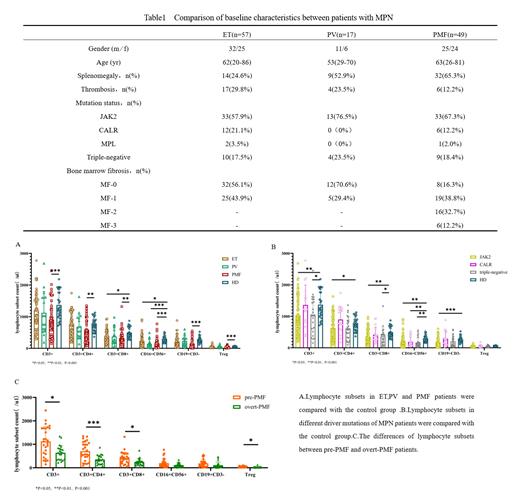Background
Myeloproliferative neoplasms (MPNs) are stem cell-derived clonal myeloid malignancies characterized by abnormal proliferation of one or more lineages of myeloid cells in the bone marrow resulting in varying degrees of increase in peripheral blood cells.BCR-ABL-negative MPN mainly include essential thrombocythemia (ET), polycythemia vera (PV) and myelofibrosis (MF). It is still unclear that the pathogenesis of MPN,but a large number of studies have shown that MPN has abnormalities in the immune microenvironment. Aiming to investigate the potential contribution of lymphocyte subsets to the pathogenesis of MPN, we investigated the peripheral blood lymphocyte subsets in MPN patients with different clinical characteristics.
Methods
A total of 123 patients (57 ET, 17 PV and 49 PMF) with MPN admitted to the First Affiliated Hospital of Nanchang University from October 2020 to February 2023 were retrospectively studied. Dynamic data of lymphocyte subsets were collected.
The levels of peripheral lymphocyte subsets were measured by flow cytometry before treatment, and their association with clinical characteristics was analyzed.
Results:
Among 123 patients with MPN,57 patients were diagnosed with ET with a median age of 62 years (range, 20-86), 17 patients were diagnosed with PV with a median age of 53 years (range, 19-70), 49 patients were diagnosed with PMF with a median age of 63 years (range, 26-81). 55 patients had varying degrees of splenomegaly, of which 14 (24.6%) patients with ET, 32 (65.3%) patients with PMF, and 9 (52.9%) patients with PV. Further comparing the incidence of splenomegaly in patients with ET, PV and PMF, it was found that the incidence of splenomegaly with PMF and PV was significantly higher than ET patients.
There were significant differences in lymphocyte subsets counts in MPN patients compared to controls. We found that CD3+ T-cell counts, CD3+CD8+ T-cell counts, CD16+CD56+ NK-cell counts, CD19+CD3-B-cell counts, and Treg counts were reduced in patients in the MPN group in comparison to controls.And patients with PMF have reduced CD3+ T-cell counts, CD4+ T-cell counts and Terg-cell counts compared to ET patients.
In different driver mutations patients we find that with CALR mutation had significantly lower CD16+CD56+ NK cell counts compared to controls,JAK2V617F mutation had significantly lower CD3 +T cell counts, CD3 +CD4 +T cell counts, CD3 +CD8 +T cell counts, CD16 +CD56 +NK cell counts, CD19 +CD3 -B cell counts compared to controls,triple negative patients had significantly lower CD3 +T cell counts, CD8 +T cell counts, CD16 +CD56 + NK cell counts compared to controls.
Different clinical presentations have different immune characteristics.Patients with ET who develop splenomegaly show decreased CD8+ T cell counts compared to non- splenomegaly patients. We did not obtain similar findings in splenomegaly patients with ET and PV.Overt-PMF patients had lower of CD3+ T cell counts, CD4+ T cell counts, CD8+ T cell counts, Treg cell counts compared to pre-PMF patients.
Conclusion
PMF patients having more impaired immune function than ET and PV patients. Immune function was impaired differently in MPN patients with different driver mutations, The immune function of JAK2V617F mutations and triple-negative patients is more severely impaired than CALR mutated patients. Patients with splenomegaly, and overt-PMF patients have more impaired immune function.This is also consistent with the prognostic differences between the different clinical characteristics of MPN.
Disclosures
No relevant conflicts of interest to declare.


This feature is available to Subscribers Only
Sign In or Create an Account Close Modal